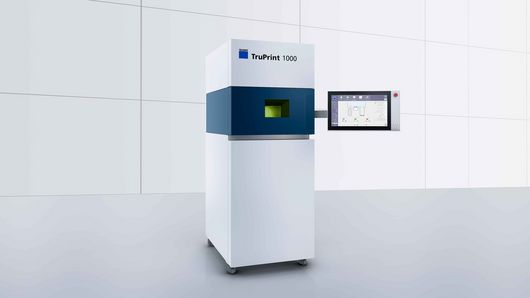Individualised series production of high-quality implants is a main application area for additive manufacturing in medical technology. Individualised patient solutions require prompt delivery of the implant to the operating theatre. The complete manufacturing process, including data generation using imaging techniques (CT scan), 3D printing and post-processing, usually takes up to a week. Availability can however be improved by adding a second laser to the TruPrint 2000. The multilaser option increases productivity and can therefore have a positive effect on the cost per part. Manufacturing medical technology products, particularly products from risk class III, requires qualified equipment and a validated process. TRUMPF offers extended services which support customers working in certified environments in questions of equipment qualification and process validation. The latest developments in process monitoring and a sophisticated concept for powder handling and preparation also contribute to the process and the quality of the powder and component.

Additive manufacturing of personalised implants for craniofacial applications
Tumour patients and patients with congenital or acquired malformations caused by trauma or atrophy often benefit greatly from an individualised patient solution (IPS). Additive manufacturing now makes it possible to produce high-quality implants with fast availability at acceptable costs – even for one-off lot sizes. Optimum patient care is guaranteed. The implants are based on the patient's anatomical data, which means faster recovery and significantly fewer surgical procedures. In many cases, the implant can even be subjected to loads immediately after surgery.
One-off medical implants can be produced cost-effectively. TruPrint machines and systems provide the ability to scale your production from one-off to mass-produced medical implants.
Benefit from individualised part design adapted to the patient's anatomy. Lattice and porous structures can also be incorporated into the implant to improve fluid and heat exchange.
Additive manufacturing enables the patient's anatomy to be reconstructed without bone augmentation. This means fewer surgical procedures and therefore less stress for the patient.
One-off productions can be manufactured on request within a short period of time to get them promptly to the operating theatre.
Examples of personalised implants in oral and maxillofacial surgery
How is a CMF implant created using laser metal fusion?
Component facts & figures

- Component dimensions: Jaw implant: 176 mm x 94 mm x 135 mm, Pre-prosthetic implant: 55 mm x 55 mm x 55 mm, Orbital implant: 41 mm x 18 mm x 34 mm
- Total build time (all components / substrate plate): 29 h (multilaser), 44 h (single laser)
- Layer thickness: 30 µm
- Number of layers: 4,677
- Weight: Jaw implant: 113 g, Pre-prosthetic implant: 10 g, Orbital implant: 1 g
- Volume: Jaw implant: 25.5 cm³, Pre-prosthetic implant: 2.3 cm³, Orbital implant: 0.3 cm³
- Customer: KARL LEIBINGER MEDIZINTECHNIK, a KLS Martin Group company






